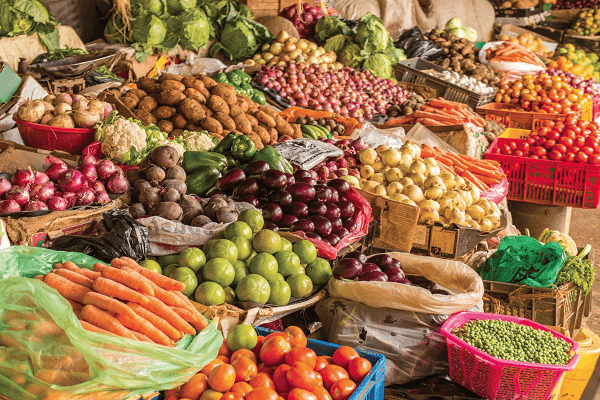Agriculture has a central socioeconomic position in Ghana. The sector accounts for more than 65 percent of the work force, slightly higher than 40 percent of GDP the gross domestic product, with almost 45 percent of foreign currencies acquired through exports.
Although agriculture is a key part of the country’s economy, the structure of the sector is vulnerable because it relies on rainfed agriculture during a roughly six-month rainy season. However, the effects of climate change is considerably cutting the number of months the country experiences rain.
With climate change, droughts and other types of unseasonable weather pose risks for farmers. Under these conditions, irrigation development offers the promise of greater food security and the rural-area development by ensuring yearlong agricultural production.
Despite considerable potential for development and the emphasis placed on irrigation development in many plans, less than five percent of the total cultivatable area in Ghana is irrigated.
Moreover, even within this small area, researchers lack a clear understanding of where in Ghana different types of irrigation infrastructure are used and to what effect. Less than a third of the estimated total irrigated land in Ghana lies within 22 well-known public schemes, and not enough is known of the location, development and management of the informal irrigation schemes that account for the remaining two-thirds of total irrigated land.
Although donors and policymakers express interest in providing new funds for irrigation development, the lack of reliable data on where irrigation currently exists, trends in its development, and opportunities and constraints within formal and informal schemes undermines consensus about how to build on what already exists in the sector.
According to MoFA, there are twenty two Irrigations Project all over the country constructed by the Irrigation Development Authority, covering a total of 6,505 hectares (ha).
In addition to this, there are other twenty-two schemes constructed under the Small Scale Irrigation Development Project (SSIDP) and six schemes under the (Small Farms Irrigation Project) SFIP. Each of these projects is less than 1,000 ha in size with the exception of the Tono and Kpong Irrigation Projects, which have about 2,500 hectares and over developed.
The agricultural sector must lead in achieving this national goal, as agriculture employs more than 50 percent of the total economically active population (Kundell 2008).
Agriculture in Ghana is predominantly practiced on smallholder, family-operated farms, which produce about 80 percent of total agricultural output.
About 136,000 km2 of land, covering approximately 57 percent of the country’s total land area of 238,539 km2 is classified as “agricultural land area” out of which about 65,000 km2 is under cultivation and about 11,000 hectares under irrigation. About 60 percent of all farms in the country are less than 1.2 hectares in size, 25 percent are between 1.2 to 2.0 hectares, with a mere 15 percent above 2.0 hectares.
Agriculture sector stakeholders have said time and over again that, Ghana cannot achieve economic growth and poverty reduction targets without significant improvement in the sector. Growth in agriculture may be achieved both through extensification (putting more land under cultivation) and intensification (increasing the productivity of existing land). In most cases, irrigation is central to increasing productivity of existing agricultural land.
The MoFA has justified irrigation development in Ghana as a way to achieve food security, poverty reduction, and rural employment. This argument is specifically related to the Northern regions, as they are characterized by mono-modal highly variable rainfall distribution.
Nevertheless, despite irrigation’s considerable potential and the emphasis placed on it in recent plans, the proportion of potential irrigable land actually under irrigation is insignificant. In addition, the performance and productivity of existing irrigation schemes, particularly those that were publicly developed, are generally low.
A ray of hope
Government in the 2023 national budget is allocating some GH200 million on irrigation development. About GH¢253 million has also been allocated for the construction of the Pwalugu Multi-purpose dam. While government must be commended for increased investment in the Pwalugu multi-purpose dam, this amount is woefully inadequate for any meaningful irrigation development.
But as government is prioritizing irrigation in Northern Ghana through the one village one dam, other parts of Ghana are equally in serious need of irrigation for dry season farming. It is observed that government’s continued program under the One Village one dam program in Northern Ghana has yielded some gains. Whiles this is appreciated, it appears that other parts of the country, specifically middle and Southern part are continuously left out of these investments.
Farmers in the Volta, Oti, Central, Western and other regions are also plagued with continuous reliance on rain fed agriculture with little or no investment in irrigation. Government should expand these irrigation schemes to cover all irrigable lands in the country.
Farmers across the country continue to struggle to access agricultural equipment and mechanization services, even in the midst of government interventions for agricultural mechanization.
Over the past years, it has become obvious that the country’s agriculture model has not been effective and does not address the mechanization and other needs of farmers.
Considering the state of agricultural and state of food insecurity, government can only take irrigation as serious as it deserves to create the necessary positive impact.
That necessary impact, must be created with a conscious effort to put irrigation first among all priorities in the sector.
With this year’s National Farmers Day Celebration, the 38th edition, themed, ‘’Accelerating Agriculture Development through Value Addition’’, the surest way to accelerate agriculture development is nationwide irrigation which would result in all-year-round farming to boost national food security.










